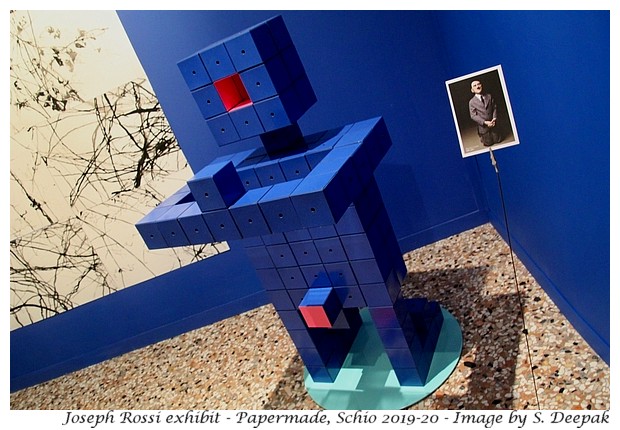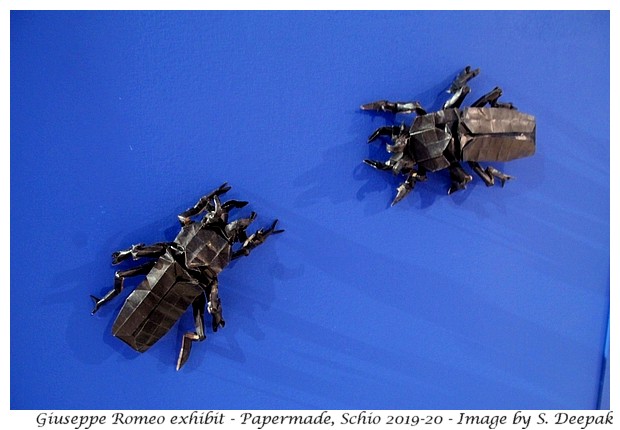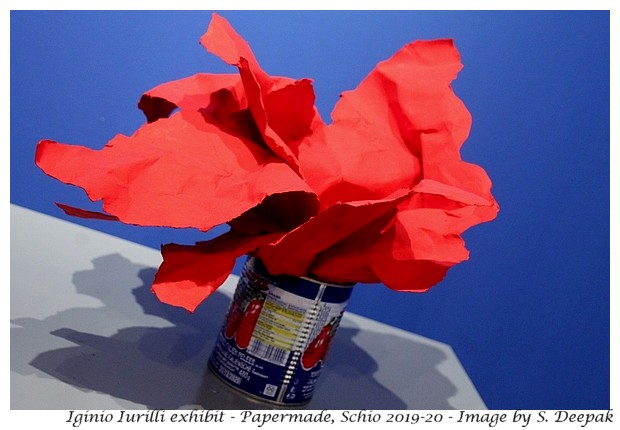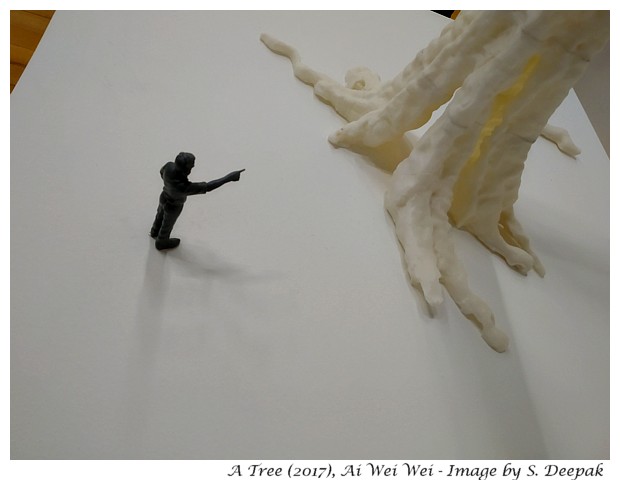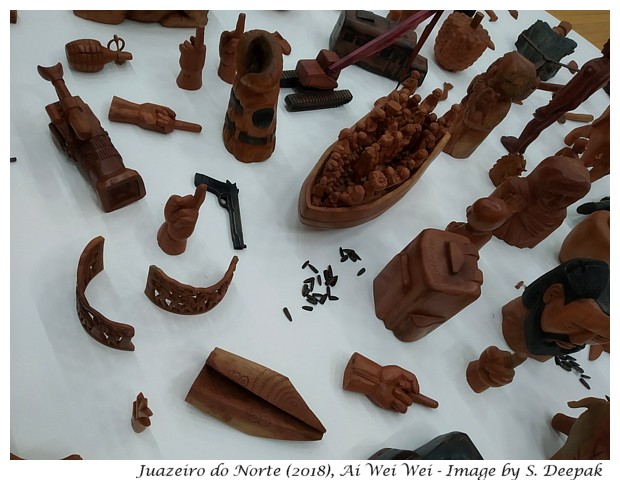Contemporary art, as displayed in the Biennales, has many works related to digital elaboration, photography, sound and video, which leave me perplexed - not because they are not art but because each of them has their own festivals and events, so I am not sure why would art biennales devote so much space to them. However, it is concept art which often leaves me feeling as a kind of idiot who can't get its point. For example, the image below has one of the works from a Kochi Biennale, which left me pulling on my fragile white hairs.
However, I am not the only one who feels confused by such art. For example, the Scottish author Alexander McCall Smith in his recent book The Peppermint Tea Chronicles, has one of the characters talking about the Turner Prize (a prestigious British award for contemporary art, which has been often given to works of concept art), which expresses my feelings very eloquently:
Recently I read a book on contemporary art by Will Gompertz, which gave me some understanding about the origins of concept art and why it leaves me cold.
In his book, Gompertz asks "Such works are often entertaining, even thought-provoking, but are they art?" His answer is "Yes. They are. Because that is their intention, their sole purpose, and the grounds upon which we are being asked to judge them. The difference being that they are operating in an area of modern art that is first and foremost about ideas, not so much the creation of a physical object: hence conceptual art. But that doesn’t give artists the right to serve up any old rubbish."
Perhaps I lack certain qualities for proper art appreciation, but I wish that the biennale curators do not dedicate so much space to Concept Art. While we areat it, I would like that the space given to video and digital art installations should also be limited.
This last quote from Gompertz does not really convince me - I don't think that art should be about learning the rules of some game. However, if you want to understand some of the most important art movements of late 19th and 20th century, read this Gompertz book - it is one of the best that I have read on this theme.
Angus was unrepentant. “I have little time for the Turner Prize,” he said. “I have no taste for its pretentiousness. I dislike the way it is awarded to people who cannot paint, draw, nor sculpt.” His eyes widened; he became slightly red, his breathing shallow - all fairly typical reactions provoked by the Turner Prize in those of sound artistic judgment. “You are not an artist if you merely make a video about paint drying or pile a few objets trouvés in a heap. You just aren’t.”
Domenica shrugged. “Calm down,” she said. “Installations make us look at the world in a different way. They must have some artistic merit. They challenge us. ...”
Origins of Concept Art
Will Gompertz in his book "What are you looking at - Strange Story of 15o Years of Modern Art" (2012) explains the origins of Concept Art with a story about Marcel DuChamp, whom he calls the father of "Concept Art" and who had pioneered the concept art movement with his work "The Fountain" in 1917 (which was a urinal he had bought in a shop):After buying the urinal Duchamp takes it to his studio. He lays the heavy porcelain object on its back and turns it around, so it appears to be upside down. He then signs and dates it in black paint on the left-hand side of its outer rim, with the pseudonym “R. Mutt 1917.” His work is nearly done. There is only one more job remaining: he needs to give his urinal a name. He chooses Fountain. What had been, just a few hours beforehand, a nondescript, ubiquitous urinal has, by dint of Duchamp’s actions, become a work of art.
At least it had in Duchamp’s mind. He believed he had invented a new form of sculpture: one where an artist could select any pre-existing mass-produced object with no obvious aesthetic merit, and by freeing it from its functional purpose—in other words making it useless—and by giving it a name and changing the context and angle from which it would normally be seen, turn it into a de facto artwork. He called this new form of art-making a “readymade”: a sculpture that was already made.
Marcel Duchamp caused the decisive rupture from tradition and forced a re-evaluation of what could and should be considered art. Before Duchamp’s provocative intervention, art was something man-made, typically of aesthetic, technical and intellectual merit, which had been mounted in a frame and hung on a wall, or presented on a plinth to look splendid. ...
Some Examples of Modern Art
Let me start with my top-10 list of some examples of concept art, which perplex me. I will start with the ones which I felt were very different from the classical canons of art but which I accepted as a kind of art. The first was an installation by Bob Gransma from a Kochi Biennale - in this, the artist had made a gigantic slab of concrete to be placed inside a dug up area. I think that it expressed the ideas of disruption, destruction, and the fragility of life.The next image has a work of Yuko Mori from a Kochi Biennale. It had metal rings on a metal stand with wires going down. I think that it was accompanied by a sound and video installation. It expressed the influence of mechanised world on the human life and people who spend their lives in factories repeating same gestures the whole day, every day.
The next image is of a work by Hassan Sharif from a Venice Biennale. It had a collection of bent aluminium spoons amidst a jumble of black plastic cords. It made me think of all the waste that we produce in our daily lives. It also reminded me of people hoarding stuff like wires, cords and bags in their cupboards because they might need them one day.
To conclude this part, I have another image from a Kochi Biennale which had a toilet by Dia Mehta Bhupal. It was also about urinals, like Du Champ's famous urinal which had started the Concept Art movement. However, the colours and designs used by the artist in this work changed the space into art and was the one which I liked most in this group.
Borderline Art
Next are 2 examples of concept art, which I felt were more borderline - I am still able to see them as a work of art but I am really not convinced about it. The first image is of a work by Takahiro Iwasaki and has some books arranged on a table, along with some coloured wires coming out of some of them.The second one is an installation of B. V. Suresh from a Kochi Biennale, which was accompanied by sound and video effects.
The Lazy Artist?
The final 2 examples of Concept Art are the ones which I found most problematic. The first was a work by an Indian artist from the Kochi Biennale - it had the trash from a building construction arranged in the centre of a room.The second example below was in the Israel pavillion in a Venice Biennale - I won't even try to describe it.
Conclusions
I agree that all the works presented above, can make us reflect and may be, see the world in a different way but I am not always sure if there was some art in them. If the art is just in a concept in the artist's head, then how do we decide who is an artist and who is not? All of us have concepts in our heads, who gets to decide if my concept is artistic? The guy who made the art by sticking a banana on a board? Or is it art, because some guy with more money than brain, bought that banana-board for a million dollars? It somehow reminds me of the story about the king's invisible clothes.In his book, Gompertz asks "Such works are often entertaining, even thought-provoking, but are they art?" His answer is "Yes. They are. Because that is their intention, their sole purpose, and the grounds upon which we are being asked to judge them. The difference being that they are operating in an area of modern art that is first and foremost about ideas, not so much the creation of a physical object: hence conceptual art. But that doesn’t give artists the right to serve up any old rubbish."
Perhaps I lack certain qualities for proper art appreciation, but I wish that the biennale curators do not dedicate so much space to Concept Art. While we areat it, I would like that the space given to video and digital art installations should also be limited.
The last image of this post (above) is an installation by Kaushik Mukhopadhayay from a Kochi Biennale - he has used old thrown away stuff to make a delightful mechanical installation - it means that art can come out of garbage, but there is a difference between making art from rubbish and serving up rubbish as art.
Let me conclude this post with another quote from Gompertz -
In my opinion the best place to start when it comes to appreciating and enjoying modern and contemporary art is not to decide whether it’s any good or not, but to understand how it evolved from Leonardo’s classicism to today’s pickled sharks and unmade beds. As with most seemingly impenetrable subjects, art is like a game; all you really need to know is the basic rules and regulations for the once baffling to start making some sense.
***











